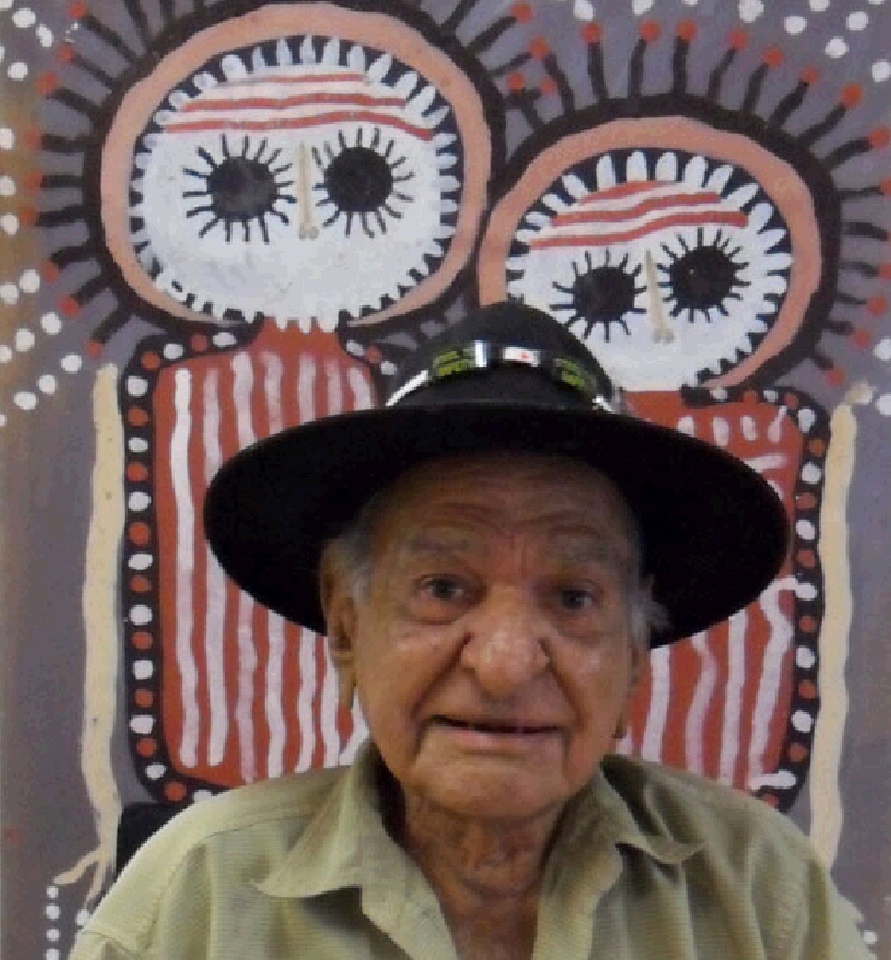Jack Dale

DOB:
c.1922 - 8 Feb 2013
Born:
Imanji (Mt House Station), Kimberleys, WA
LANGUAGE GROUP: Ngarinyin
COMMUNITY: Derby, WA
The Kimberley is a unique and special part of Australia and considered to be one of the most remote, wild and beautiful regions on earth. The dramatic, stunning landscape continues to seduce and tantalise visitors and is fast becoming a popular tourist destination. Despite the sheer beauty of this untouched region, there lies a dark and violent history of colonial contact that is still within living memory of a depleting number of elders, with tangible evidence of the conflict and brutality still marked within the landscape.
Jack Dale was one of the last remaining Kimberley elders whose life is Kimberley history personified. His life story has been recorded by historians and academics, and for 15 years he used painting as a method to tell his story from his own unique perspective and aesthetic.
Records recently obtained from Births, Deaths and Marriages confirms that Jack was born between 1920 and 1922, placing him in his nineties when he sadly passed away in 2013. He was born in the bush at Mt House Station (Imanji country). His mother was a Ngarinyin woman and his father was a hard-living and brutal Scottish frontiersman. His father once shot Jack in the leg to stop him from 'running away'. Naturally, his mother tried to keep him away from his violent white father.
When his father passed away, Jack's Aboriginal grandfather took him under his wing, teaching him Narrungunni law and protecting him from the prevailing social attitudes towards 'mixed blood' children. During this time Jack saw many things that would later be the subjects of his paintings; hiding in the bush as police patrols forcibly took Aboriginal children from their families, watching chain gangs of Aboriginal men being marched away to the Prison Tree, and the arrival of the Afghan camel drivers.
Jack went on to live a remarkable life that bridged two cultures. For most of his life, he worked as a stockman and was greatly revered as a skilful, tough and uncompromising man who was never 'thrown from a horse or defeated by a beast'. He was also a respected Aboriginal elder and lawman and was considered one of the last of a generation of old men who possess a complete knowledge of the rituals, law and culture of his people. He was a vital link to the past and still is to this day through his art.
Jack began to paint in the 1990's with rigour and excitement. In his later years he was forced to retire from painting following a spate of heart attacks which placed him in serious danger and saw him admitted to a home. The resilient man that he was, before he passed away, he did begin to visit the studio again to follow his painting career with a vengeance - and as much enthusiasm as he had in the 90's. His story truly is remarkable.
Jack produced large ceremonial boards used by traditional dancers to re-enact dreaming stories. He also used his extensive cultural knowledge to record aspects of the Wandjina dreaming sites of his people.
The Wandjina is an iconic powerful spirit man of the Kimberley, who forms clouds, rain and the landscape, and who, in Jack's paintings, is distinguishable by its large circular eyes, round head and halo formation. The eyes are most arresting eyes and entice the viewer in to the work. Jack managed to capture the power and strength of the Wandjina with the use of strong lines and dots which give the artworks a pulsating energy.
He used large blocks of colour outlined with dots, which is synonymous with the Kimberley region, and then would add figurative motifs of boab trees, horses, aeroplanes and people to tell his story. Whilst originally painting in natural ochre, Jack's later works were painted with Acrylics which allowed him to use vibrant hues, including blues, reds and yellows.
While the subject matter of his artworks was at times grim, and to the western eye, the Wandjinas may seem confronting, the spirit and energy of his naive style works overcome this initial response.
Despite all, there is an enchanting and buoyant spirit in his art (as there was in this resilient man). The stories behind each of his works add an extra dimension to Jack's paintings and when understood, add to the fascination of these paintings. They are a unique and often humorous record of a long life lived deep within traditional Aboriginal law and yet also in the dangerous 'whitefella' world at the frontier of Kimberley life. These paintings raise your interest and beg to be talked about and considered. They are indeed a doorway to a greater understanding of Australia's history, a fact that makes his artworks highly collectible and the basis for great dinner party discussions.
Jack Dale was and remains an important and significant man as he is part of the history of the Kimberley region and its Indigenous people. Interest in his work has increased exponentially through his many solo exhibitions. His art can be seen as important historical and cultural documents, which could equally hang in a fine art gallery or a museum, where their anthropological value is outstanding, providing authentic, first-hand information regarding Australia's history.
Copyright Kate Owen Gallery 20 August 2020. Updated 3 September 2020
